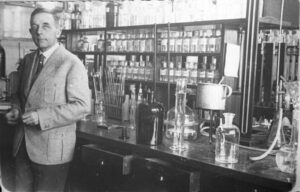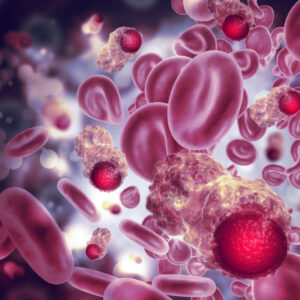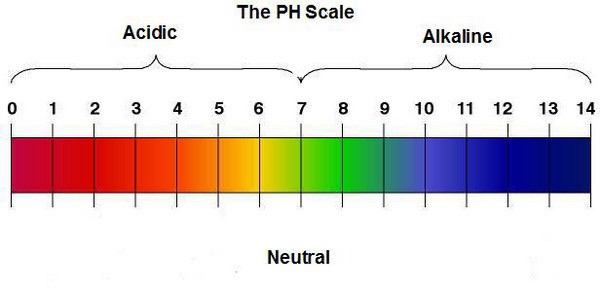
Who is Otto Warburg?
Until about a hundred years ago, diseases from which people mostly die today were almost unknown, such as cancer, heart disease, diabetes, etc. And then in the 20th century, these diseases took on epidemic proportions, especially cancer. In 1931, Dr. Otto Warburg received the Nobel Prize for discovering the cause of cancer. In his work "Tumor Metabolism", Dr. Warburg showed that due to an unhealthy diet and insufficient physical activity, the body creates an acidic environment that is poorly supplied with oxygen. "When you deprive a healthy 35% cell of its oxygen, you can turn it into a cancer cell in just two days," claimed Dr Warburg. Cellular acidity displaces oxygen, and the lack of oxygen in the cells creates an acidic environment. If you have too high acidity, you will automatically lack oxygen in your body; if you don't have enough oxygen, you will have an acidified body.
An acidic environment is an environment without oxygen. "Lack of oxygen and acidity are two sides of the same coin: if someone has one, they also have the other," said Dr. Warburg. An acidic or alkaline state is measured by pH values from 0 to 14, where 7 is a neutral value. From 0 to 7 is acidic, and from 7 to 14 is alkaline.
How do our cells work?
In order for our cells to function successfully, they require a slightly alkaline pH, slightly above 7.
In a healthy person, the blood pH is between 7.35 and 7.45. To check your Ph you can buy Ph strips or a digital device.
Dr. Warburg discovered that cancer cells do not breathe oxygen and cannot survive in the presence of high concentrations of oxygen. In other words, cancer is nothing but a defense mechanism that our cells use to survive in an acidic environment without the presence of oxygen.

Acidified organism and lack of oxygen cause not only cancer, but also many other diseases, weakening of the organism and tendency to injuries. Whether our body will be acidic or alkaline depends primarily on what we eat. Foods that dramatically acidify our body are: meat and meat products, milk and dairy products, processed plant products, alcohol, coffee, cocoa (chocolate), generally all medicines (pharmaceutical products) and especially refined (white) sugar.
Foods that make our body alkaline are: raw fruits, vegetables, grains and nuts. It should be said that some cereals are slightly acidic,
but an ideal diet also requires a certain percentage of acidity, so cereals in combination with other raw plant foods are the best source of nutrition.
Consuming pure still water is important for oxygen production, while physical activity maintains the body's alkalinity by supplying oxygen to the whole body. Dr. Warburg's research only confirmed what was known and practiced by the entire human body
history.
 The acidity of the body is suitable for the development of many diseases (low energy level, chronic fatigue, excessive mucus production, frequent colds and infections, nervousness, irritability, brittle nails, dry hair and skin, cyst formation, headaches, painful joints and arthritis, neuritis, muscle pains and spasms, gastritis, cancer, autoimmune diseases...), so in a healthy and balanced diet it is important to maintain a neutral reaction of the body. This is achieved by choosing the right foods, because the acid neutralizes the base and vice versa.
The acidity of the body is suitable for the development of many diseases (low energy level, chronic fatigue, excessive mucus production, frequent colds and infections, nervousness, irritability, brittle nails, dry hair and skin, cyst formation, headaches, painful joints and arthritis, neuritis, muscle pains and spasms, gastritis, cancer, autoimmune diseases...), so in a healthy and balanced diet it is important to maintain a neutral reaction of the body. This is achieved by choosing the right foods, because the acid neutralizes the base and vice versa.
A little reminder of chemistry lessons: The basicity and acidity of a substance are determined using the pH value (hydrogen ion concentration). In doing so, the concentration of hydroxide ions (OH) is measured, which give pH values greater than 7 and a basic reaction, or the concentration of hydrogen ions (H), which give pH values less than 7 and an acidic reaction. But what role do bases and acids play in the body? Do they give or take energy? The reaction in which bases are formed implies any chemical change in the body due to which its energy increases, and the urine becomes alkaline. A reaction in which acids are formed implies any chemical change due to which the body's energy decreases and the urine becomes acidic. All organs in the human body function normally only when the amounts of basic and acidic substances in the body are in the right balance.
For example but even slightly acidic blood can cause a number of problems, not only in the heart but also in the kidneys, lungs, and liver. All food after passing through the gastrointestinal tract first comes to the liver. This is why the burden on the liver is greater if waste acids are constantly circulating in the blood.
Here is a list that expresses the degree of acidity and alkalinity of certain types of food. The higher the number (blue), the more alkaline (basic) the food is. The smaller it is (red), the more acidic it is.

pH 9.0 – Lemon, watermelon
pH 8.5 – Melons, grapes, parsley, kiwi, pears, pineapple, raisins, umeboshi plums, vegetable and fruit juices, dried figs, dried dates, peppers, mango, papaya, raspberries, tangerines, onions.
pH 8.0 – Fresh dates and figs, sweet apples, apricots, bananas, carrots, celery, garlic, avocado, grapefruit, lettuce, nectarines, peaches, pumpkins, spinach, broccoli.
pH 7.5 – Sour apples, beets, cabbage, cauliflower, ginger, potatoes, strawberries, olives
pH 7.2-7.3 – Almonds, homemade cucumbers, artichokes, cherries, cucumbers, homemade honey, mushrooms, ripe and fresh olives, radishes, sesame seeds, tomatoes, olive oil, various spices, coconut and linseed oil.
pH 6.7-6.8 - Plums, prunes, coconut, and most of its products, pistachios, beans, pasteurized honey, pumpkin and sunflower seeds, vanilla...
pH 6.5 - Bread made from oats, rye, barley, rice, integral rice, corn bread, soy milk, soy cheese, almond and sesame oil, sunflower and grape oil.
pH 6.0 – Fish, cheese, ketchup, mayonnaise, fruit juices with sugar, cigarettes (from fresh tobacco), popcorn, pickles, goat's milk, mustard, molasses, cow's milk, turkey, shellfish, duck meat, casein (milk protein), refined grains ( such as corn flakes), fat, palm oil, sweetened yogurt, peanuts, cranberries, processed cheese.
pH 5.5 - Beef, white flour, pork, lamb, dough and cakes made from white flour, fried food, all sugars, cigarettes (factory), yeast, refined salt and iodized salt, white rice, cottonseed oil, vinegar (all but apple cider vinegar).
pH 5.0 – Artificial sweeteners
pH 4.0 – Wine, spirits, coffee
pH 2.5 - Beer
pH 2.0 – Cocoa, various non-alcoholic carbonated and non-carbonated drinks, coca cola, all medicines, synthetic psychedelic drugs, pesticides, herbicides...
It's interesting, yes thermal processing of alkalizing foods, let's say fruits and vegetables, they become acidifying if they are overcooked and prepared with oil. According to researches of Hay, Shelton and others, the constant intake of large amounts of acidifying foods burdens the organism and is most often the cause of disorders and the appearance of diseases. Their recommendation is that most (80%) foods should be alkalizing, and only 20% should be acidifying. In these 20% acidifying foods, it is best to use mildly acidic foods in their raw form such as grains, some legumes, seeds and nuts.
Tips for acid-base balance:
* chew food at least 35 times, because saliva adds a basic quality to each bite
* green leafy vegetables should be added to every meal
* devote 25 minutes to breathing exercises every day, as this improves the pH balance
* moderate exercises enhance detoxification and elimination of acidic substances from the body.
The role of calcium in maintaining optimal blood pH
Calcium is one of the most important minerals for creating alkalinity. The human body contains as much as 2% of calcium or an average of 1.2 kg. This mineral has a positive effect on numerous body functions precisely because it perfectly regulates the acid-base balance in all body fluids. Blood is the most important in establishing this balance, and that is why the body makes sure that the blood has a pH value of 7.4, even at the expense of other body fluids. If the blood had a pH of 6.0, it would be acidic, we would not have enough oxygen and death would occur. That is why the body defends itself in such a way that it draws calcium from the bones and thus regulates its own pH value. And this is precisely the cause of many diseases.
If you have any questions, feel free to contact the team of experienced phytotherapists for a free consultation: 092 352 7589 or 099 645 0504




